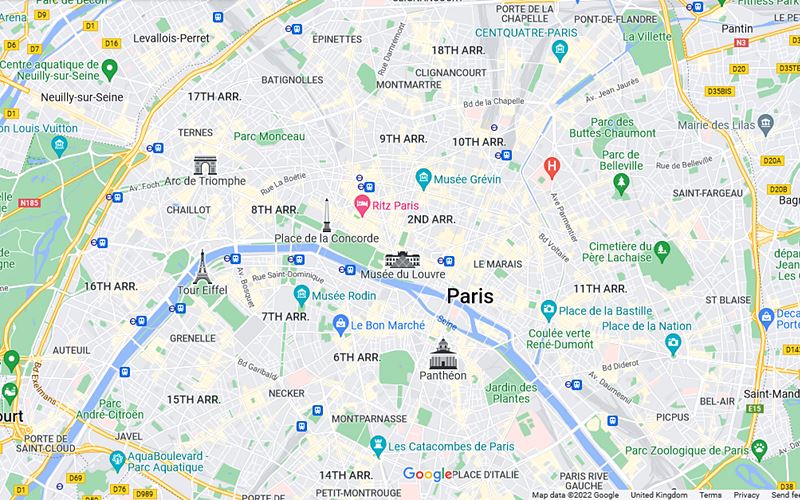Some links on this page are affiliate links. They may generate revenue for this site but there’s no extra cost to you if you make a purchase. More on affiliate links
What you need to know for planning a trip to Paris
Paris has so much to offer and not surprisingly one of the most visited cities in the world. More than 19 million international visitors visited the French capital in 2019 before the Covid-19 pandemic. Tourists are now coming back as international borders open up for travel.
There are plenty of reasons to like the French capital. It seems you can never get enough that many return again. It’s a wonderful city to explore with plenty of history to tell and amazing sights to see. Not to mention loads of shopping opportunities, gastronomic foods and the famous café culture.
It’s a great travel destination but there are things you need to know to prepare for a trip. This Paris travel guide is here to help you with useful travel information. It includes advice and tips on the best time to visit, how to stay safe, places to visit, eating out, how to get around, where to stay, day trips and more.
YOU MAY ALSO LIKE
- Top Tourist Attractions in Paris
- Best Neighbourhoods in Paris
- Best Places to Shop in Paris
- MORE ON PARIS
- Best Time to Visit Paris
- Staying Safe in the City
- Your Health
- Budgeting a Trip to Paris
- Tourist Information Centres
- Top 10 Tourist Attractions
- Hop-on Hop-off Bus Tours
- Boat Tours of Paris
- Best Places to Shop
- Guide to Eating Out
- How to Get to Paris
- How to Get Around
- Where to Stay in Paris
- Best Day Trips From Paris
Best Time to Visit Paris

When is the best time to visit the French capital? As a matter of fact, Paris receives tourists across the four seasons. There are for and against for each namely the weather, cost and the tourist crowd. So when is the best time depends on what you’re looking for. After considering all the factors, you may prefer one season over the other.
Paris has a maritime climate moderated by the Atlantic Ocean. Winters are usually above freezing and summers warm. That being said, you can expect occasional cold spells and heat waves, which are becoming more frequent with climate change. The table below are the average daily highs and nightly lows in Paris.
| Month | Average Highs – Lows (Celsius/Fahrenheit) |
|---|---|
| Jan | 7°C – 3°C 45°F – 37°F |
| Feb | 8°C – 3°C 46°F – 37°F |
| Mar | 12°C – 5°C 54°F – 39°F |
| Apr | 16°C – 7°C 61°F – 45°F |
| May | 20°C – 11°C 68°F – 52°F |
| Jun | 23°C – 14°C 73°F – 57°F |
| Jul | 25°C – 16°C 77°F – 61°F |
| Aug | 25°C – 16°C 77°F – 61°F |
| Sep | 21°C – 13°C 70°F – 54°F |
| Oct | 16°C – 10°C 61°F – 50°F |
| Nov | 11°C – 8°C 52°F – 46°F |
| Dec | 8°C – 3°C 46°F – 37°F |
Each season has its own charm and whatever the season, there’s always plenty to see and do. When is the best time to visit Paris depends on the individual traveller. If you’re unsure when is your best time, then this section of the Paris travel guide will help you decide. So lets take a look at the four travel seasons.
Peak Season (June-August)
It’s warm and sunny weather in summer from June to August. Days are long and there’s plenty of sunshine to enjoy your time. But temperatures sometimes go way above 30°C (86°F). Summer showers come and go quickly and are usually light. Remember to wear light clothes, a hat and to drink plenty of water.
Many outdoor events occur during this season. There’s the Bastille Day Parade and firework extravaganza near the Eiffel Tower on 14th July. The famous Tour de France comes to a close in Paris around the end of July. Parc de la Villette turns into an open-air cinema from mid-July to mid-August. And these are just the tip of the iceberg.
Summer is a great time to come but there’s a downside. It’s the high season for visiting when the city gets crowded with hordes of tourists. There are long queues to visit many of the popular attractions in Paris. Besides, there are long waits to be served at packed restaurants. Not to mention accommodations are at their most expensive.
1st Shoulder Season (September-October)
Autumn which starts in September gets cooler and drops further in October. The days also get shorter and you can expect occasional rain showers. But there are still 11-12 hours of daylight to explore and take amazing photos. Overall, it’s a nice time to visit if you prefer cooler temperatures than summer but not cold weather.
September and October are the shoulder season for visiting. The tourist crowd are still there but fewer compared to summer. Waiting in line gets shorter and you can enjoy the restaurants without waiting too long to be served. Accommodations are also cheaper. Considering the weather and everything else, this is also a good time to visit Paris.
Low Season (November-March)
November to March are the cold months as winter sets in with the coldest months being December-February. But temperatures seldom drop below freezing and if any snow, it’s usually light with thin blankets. You can expect shorter days with fairly grey skies with the shortest in December when there’s just around 8 hours of daylight.
There are not many tourists during this period. But it does increase momentarily from mid-December till the end of the year for the Christmas and New Year holidays. Besides not having to elbow your way through the crowd, it’s a great time to save on travel expenses. This is when hotels offer their cheapest rates to fill their empty rooms.
Queues are shorter and visiting the attractions are quieter without the crowd. With this in mind, it’s a great time to visit indoor attractions including museums. In December, Christmas lights glitter many areas such as Champs-Elysées, Place Vendome and Montmartre. And there are lively Christmas markets studded across the city.
2nd Shoulder Season (April-May)
April and May are the second shoulder season as Spring sets in. Temperatures get warmer but it’s cool and comfortable – off and on you can expect chilly nights in April. The days become longer with more than 13 hours of daylight. With the cool weather and longer days, you’ll have more time to spend outdoors compared to winter.
Yes, more tourists are coming after a slowdown in winter but the horde have not yet arrived. There’s no need to wait in long queues and elbow your way through. Though rates for accommodations are starting to creep upward, they have yet to skyrocket. Besides, you can still find rooms at good bargains.
Staying Safe in the City

With all the bad news you may have heard about Paris, you wonder whether the city is safe to visit. The risk of violent crimes like murder, kidnapping, muggings, robberies and assault is actually low. Paris isn’t among the most violent cities in the world. Besides, France has tough gun laws and police do their best to keep the city safe.
Paris is a safe destination for tourists. But like any city, it does have its share of crime. The following is not meant to scare you. It’s to inform you about the most common crimes affecting tourists so you’ll be on the alert. Anyway, most visitors enjoy their time in the French capital without such encounters.
Pickpockets
The most common crime among tourists is pickpocketing. Crowded places like tourist frequented areas, public transportation and shopping centres are popular spots for crafty fingers. Pickpockets prey on tourists who are too busy to notice. They often work as a team, one distracting the victim and the other with a hand in the pocket.
Many pickpockets are in their teens and some even younger. So be on the alert if a group of youngsters get close to you. Some are well-dressed adults and some you may even think are tourists. Paris has a significant ethnic population but shouldn’t stereotype. Just be alert when someone gets close to you, whoever they are.
All it needs are simple precautions to protect yourself. First of all, use the hotel safe to keep things you don’t need to carry. If staying in a hostel, use the security locker. Here are some practical tips when out enjoying Paris.
- Remember to be aware of your surroundings.
- Never leave your belongings like bags and phones unattended.
- Don’t carry more cash than you need and don’t flash your valuables.
- Don’t put your wallet or phone in your back pocket.
- Wear a money belt inside your shirt and not outside.
- Place a dummy wallet in an easy location as a decoy.
- Use a safety pin to “lock” your pocket.
- Carrying a bag, keep valuables inside the zip compartment.
- Better still, use zipper locks to prevent theft.
- Sling your bag in front of you and not on your shoulder.
Tourist Scams
Scams are the next most common crime affecting tourists. Where there are lots of tourists, you’ll find them. Areas around the Eiffel Tower, Louvre Museum, Arc de Triomphe, Champs Elysées and Montmartre are frequent spots. Other places include markets, public transportation, tourist restaurants and bars.
Tourist scams are not just in Paris but all over the world. Gullible and trusting tourists who don’t know what’s coming are the easiest targets. And scammers can be very persistent. Here are some common scams in Paris to be on the alert.
- Someone picks up a gold ring and tells you that you’ve dropped it. You say it’s not yours but the person says it’s a nice ring and begs you for money in return.
- A person meets you saying they are from a charity. They show a letter or photocopy that looks like from a legit charity and then ask for a donation.
- A friendly-looking person comes to you offering a handshake. You stick your hand out, and the person ties a “bracelet” around your hand and then demands money.
- Someone approaches you and tells a sad story about their heart-wrenching situation. They then beg you for money to help them out.
- You’re looking for the ticket booth and a person offers you a ticket at a cheap price. You think you got a deal and pay but turns out to be a fake.
- A person walks up to you and gives you a rose as a “gift”. You accept it and then the person demands money even if you try to return the flower.
Scammers prey on a person’s politeness and compassion. The best way to avoid scammers is to ignore them. Remember, scammers succeed once you let your guard down. If a stranger approaches you:
- pretend not to hear them,
- don’t talk to them,
- avoid eye contact and
- walk away.
Your Health

No one wants to get sick when travelling but these things can happen. Fortunately, medical treatment is readily available in Paris whether it’s a small case of the common cold or a medical emergency. If you don’t speak French, ask if the provider speaks English. Many pharmacists and doctors in the city speak at least basic English.
Pharmacies
Visit a pharmacy if you have a minor ailment. To find one, look for the “PHARMACIE” and green cross sign on the shopfront. It shouldn’t be hard to find with 1,000 or so across the city. Most are independently owned while the Paris Pharma chain is actually a franchise. Opening times are usually Monday-Saturday from 9 AM to 6 PM.
Buying prescription and non-prescription drugs (like pain relievers and cough remedies) in France is only from a pharmacy. A qualified pharmacist is always on hand to attend to minor ailments. Pharmacies also sell homoeopathic remedies, vitamin pills, facial cleansers, shampoos and other healthcare products.
Seeing a Doctor
There are doctors operating in private offices for non-emergency medical issues. Ask the hotel front desk, manager at a rental, staff at a tourist office or pharmacist if you don’t know where to find one. Charges for seeing the doctor is usually around €25 and if given a prescription, bring it to the pharmacy.
Call SOS Médecins if you want a doctor to visit you. Doctors at SOS Médecins are available for house calls 24/7. One will arrive within an hour to treat the patient and give advice. The service is not for life-threatening medical emergencies though. Costs vary depending on the circumstances and are usually €70-130.
Medical Emergencies
You can go to any hospital if there’s a medical emergency. Or dial 15 for SAMU, France’s national ambulance and emergency service. The ambulances are equipped and managed by medics trained to handle life-threatening emergencies. You can also dial 112, the emergency number used throughout Europe.
An ambulance will take you to the nearest hospital and there are 39 public facilities in Paris and the suburbs. American Hospital and Franco-British Hospital are also available if you prefer a private hospital with English-speaking staff. But expect to pay a lot more in medical bills than at a French public hospital.
Budgeting a Trip to Paris

How much does it cost to visit Paris? Before we begin, the French capital is one of the most expensive cities for tourists. But this hasn’t stopped 19 million international visitors from coming to Paris in 2019. In fact, the city attracts all kinds of travellers from backpackers on a shoestring to tourists with deep pockets.
You can skip shopping and all the paid attractions on any trip. But not expenses for accommodation, food and transportation. The following will give you a general idea how much a single traveller will spend in Paris based on the travel budget.
- Small budget – €45 to €90 per day
- Mid-range – €115 to €200 per day
- High-end – €270 to €380 per day
The following is a guide on how much you need to budget (per person) for accommodation, food and transportation. Each visitor is different and some may set a smaller budget for some items but bigger for others. For example, you may want to set a small budget for transportation, mid-range for food and plan to stay at a high-end hotel.
Accommodation
If travelling solo and just want a place to sleep, you can get a bed at a hostel for €20-25 per night. It’s €30-50 for a room at a budget hotel. You can get cheaper mid-range (3-star) and high-end (4 to 5-star) hotels outside the city’s central area. Split the cost if staying as a couple or group to calculate the budget per person.
| Budget Type | Daily Costs (€) |
|---|---|
| Small | 20 – 50 |
| Mid-Range | 70 – 120 |
| High-End | 150 – 230 |
Food & Drinks
You can always pick a croissant and coffee from a bakery or pastry shop for €3. Cheap takeaways like kebabs with fries cost around €8 and fast foods like McDonald’s €9. You can get a good meal at an inexpensive restaurant or café for €15. Many mid-range restaurants, outside the touristy areas, offer set lunch menus for around €25.
| Budget Type | Daily Costs (€) |
|---|---|
| Small | 20 – 30 |
| Mid-Range | 30 – 50 |
| High-End | 70 – 90 |
Transport
The Metro trains are convenient to get around the city and a one-way ticket costs €1.90. The 1-day Navigo pass offers unlimited travel on the Metro and all the public transport networks. The pass cost €7.50 to €17.80 depending on the zones covered. The minimum fare on a taxi is €7.10 and you can easily spend €10-20 for a single trip.
| Budget Type | Daily Costs (€) |
|---|---|
| Small | 5 – 10 |
| Mid-Range | 15 – 30 |
| High-End | 50 – 60 |
Attraction Tickets
You can enjoy Paris on the cheap without spending on ticketed attractions. There are famous landmarks you can admire outdoors as well as lovely neighbourhoods, beautiful parks and lively markets to explore. To say nothing of scenic strolls along the River Seine. There are also free museums like Musée Carnavalet and Musée Cognacq-Jay.
Then again, you may want to visit the ticketed attractions. How much to budget depends on your interest and decide whether it’s worth your money. Entry fees to the museums cost €10-30, Eiffel Tower €27, Louvre Museum €17, Orsay Museum €16 and Sainte-Chapelle €12. And a day trip from Paris would set you back €50 to €250.
Tourist Information Centres
The Paris Region Tourist Board operates several Tourist Information Centres. Pick up some free guides to Paris including promotional materials and maps. Multilingual staffs are available to advise visitors with their travel queries. They also offer hotel bookings, transport cards, tickets and passes to various attractions. Locations include:
- Charles de Gaulle Airport – There’s one located at Terminal 2E and another at Terminal 2F. The offices are open daily except Sundays from 7:00 AM to 3:00 PM.
- Orly Airport – Located at Terminals 1 (7:15 AM to 8:30 PM), 3 (2:15 PM to 8:30 PM) and 4 (7:15 AM to 2:30 PM). The office opens daily except Sundays.
- Galeries Lafayette – There’s a small tourist office at this famous department store on Boulevard Haussmann. Opens daily from 11:00 AM to 7:00 PM.
- Disneyland Paris – The office is in front of Gare de Marne la Vallée, the railway station at Disneyland Paris. Opens daily from 9:00 AM to 8:45 PM.
- Villages Nature Paris – A retreat about 20 minutes from Disneyland Paris and located at the Welcome Centre. Opens daily except Sundays from 10:00 AM to 6:00 PM.
The Paris Convention and Visitors Bureau also operates tourist offices called Welcome Centres. Two are full service offering tourist information and tickets. Another two are Visitors Bureau partners providing only information services. Their locations include:
- Hôtel de Ville – Full service office at Paris City Hall on Rue de Rivoli. Opens daily except Saturdays from 10:00 AM to 6:00 PM.
- Gare du Nord – Full-service office at the busiest railway station in Paris and near platforms 7-9. Opens daily except Sundays from 9:00 AM to 5:00 PM.
- Carrousel du Louvre – Bureau partner and located at the shopping centre’s reception counter. Opens daily except Tuesdays from 10:00 AM to 8:00 PM.
- Travel WiFi – Bureau partner and travel accessories store near Opera Garnier. Opens daily except Sundays from 10:00 AM to 7:00 PM.
Top 10 Tourist Attractions
There are so many things to see and do in Paris that it’s impossible to cover every one of them. There’s no shortage but if this is your first trip, how do you decide where to go? Having said that, you certainly want to visit the jewels especially if you’re here for a short stay. So here’s a list of 10 trusted favourites to put you on the right start.
Before we begin, summer is the time when Paris receives swarms of tourists. For many of the popular attractions like the Eiffel Tower and Louvre Museum, it’s often a long line to buy tickets and then a long wait to get inside. The best time to escape the crowd is to come early in the morning before the hordes of tourists arrive.
Avenue des Champs-Élysées
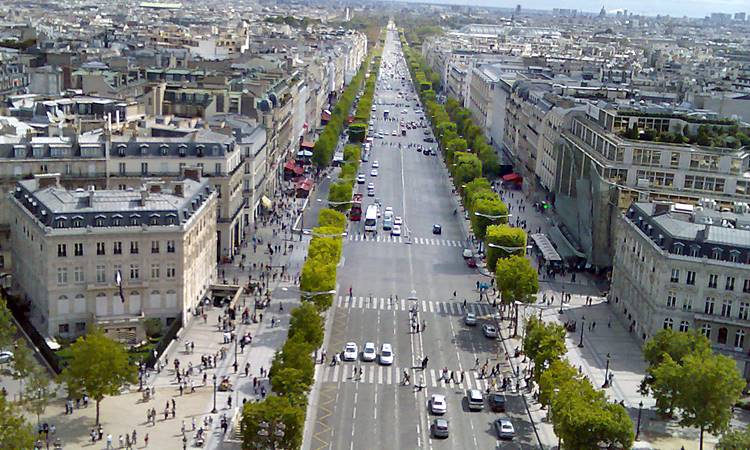
- Location: 8th arrondissement
- Metro stations: George V (Line 1), Franklin D. Roosevelt (Lines 1, 9), Champs-Élysées-Clemenceau (Lines 1, 13)
Avenue des Champs-Élysées is one of the world’s most famous streets. The avenue is the place to be seen and a beautiful tree-lined stretch featuring graceful Haussmann architecture. It’s a glamourous and exclusive part of Paris occupied by upmarket hotels, restaurants, cafés, luxury boutiques and flagship stores.
La Tour Eiffel

- Location: Champ de Mars, 7th arrondissement
- Metro stations: Bir-Hakeim (Line 6), École Militaire (Line 8)
- See tickets and tours to the Eiffel Tower
La Tour Eiffel (Eiffel Tower) soars 324 metres (1,063 feet) above the city. When it opened in 1889, Parisians viewed the tower as an iron monstrosity. Today it’s a beloved and famous city icon. There are observation platforms on three levels, offering some of the best views of Paris including many famous landmarks.
Arc de Triomphe
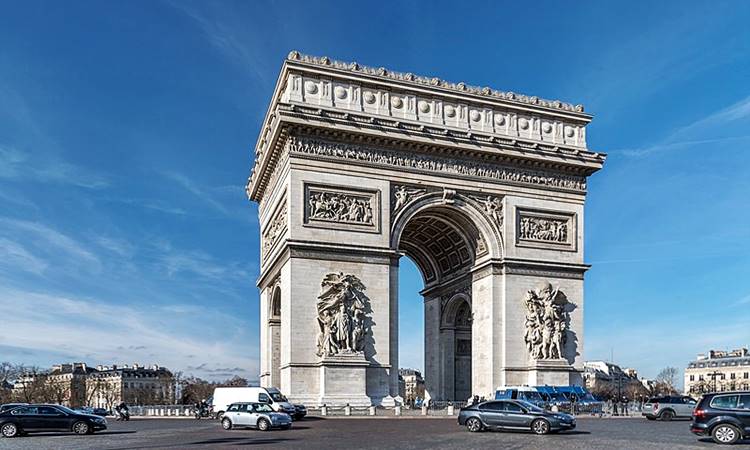
- Location: Place Charles de Gaulle, 8th arrondissement
- Metro stations: George V (Line 1), Kléber (Line 6), Ternes (Line 2)
- See tickets and tours to Arc de Triomphe
Arc de Triomphe (Triumphal Arch) is another famous city icon. Completed in 1836, this gigantic arch is 50 metres (164 feet) tall and pays tribute to those who fought and died for France. Beneath the arch is the Tomb of the Unknown Soldier and the eternal flame. Walk to the top of the arch and it’s another panoramic view of the city.
Sainte-Chapelle

- Location: Île de la Cité, 4th arrondissement
- Metro station: Cité (Line 4)
- See tickets and tours to Sainte-Chapelle
Sainte-Chapelle (Holy Chapel) is a magnificent Gothic church that dates back to the 13th century. The biggest draw is the stained glass windows, considered some of the finest and most impressive in the world. The upper level is almost entirely of stained glass. The interior is also richly decorated with sculptures, carvings and frescoes.
Musée du Louvre

- Location: Rue de Rivoli, 1st arrondissement
- Metro stations: Palais Royal–Musée du Louvre (Line 1), Pont Neuf (Line 7)
- See tickets and tours to Musée du Louvre
Musée du Louvre (Louvre Museum) is a colossal museum and the most visited in France. It’s the world’s largest devoted to art and a varied collection from Ancient Egypt to the 19th century. The museum also has the largest collection by European masters including Leonardo da Vinci, Michelangelo, Rembrandt, Raphael and Reuben.
Centre Pompidou

- Location: Place Georges Pompidou, 4th arrondissement
- Metro stations: Rambuteau (Line 11), Hôtel de Ville (Line 1)
- See tickets and tours to Centre Pompidou
Centre Pompidou is a huge futuristic-looking complex. Within is Musée National d’Art Moderne (National Museum of Modern Art), the largest in Europe devoted to modern art from the 19th century to the present. It’s an amazing collection in various forms and styles that include art by celebrated artists like Dali, Matisse, Picasso and Andy Warhol.
Musée d’Orsay

- Location: Rue de la Légion d’Honneur, 7th arrondissement
- Metro station: Assemblée Nationale (Line 12)
- See tickets and tours to Musée d’Orsay
Musée d’Orsay (Orsay Museum) is another renowned museum devoted to modern art. It’s home to some of the finest impressionist and expressionist art from the mid-19th to early 20th century. Collections include paintings and sculptures from renowned masters like Van Gogh, Renoir, Rousseau, Modigliani and Courbet.
Montmartre & Sacré-Coeur Basilica
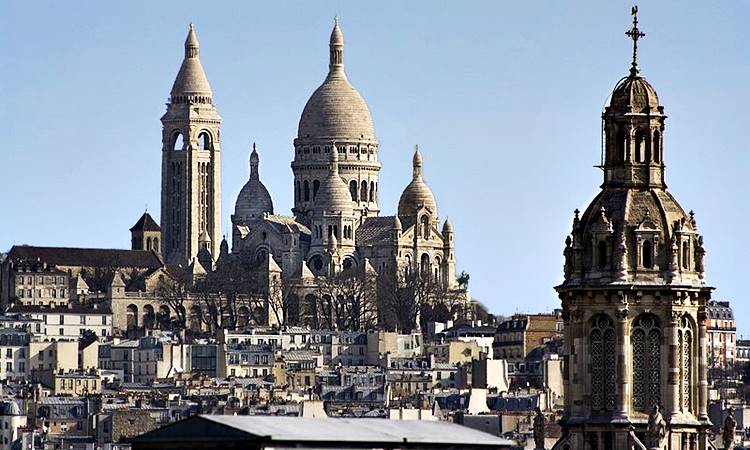
- Location: 18th arrondissement
- Metro stations: Abbesses (Line 12), Anvers (Line 2), Pigalle (Lines 2, 12)
Montmartre is a hillside village that’s a world apart from metropolitan Paris. It’s a step back in time, a charming place of narrow cobblestone streets, tight alleys, hidden steps and rustic buildings. Perched on the hilltop is Sacré-Coeur Basilica, an early 20th-century church with Roman-Byzantine features and huge domes.
Quartier Latin

- Location: 4th & 5th arrondissements
- Metro stations: Cluny La Sorbonne (Line 10), Saint-Michel Notre-Dame (Line 4), Place Monge (Line 7)
The old part of the Latin Quarter is within the boundaries of the River Seine, Boulevard St-Michael and Boulevard St-Germain. It’s an old quarter from the Middle Ages and a maze of cobbled lanes, antique buildings and medieval churches. It’s also a lively place occupied by cute cafés, lovely restaurants, tiny shops and entertaining nightlife.
Jardin des Plantes
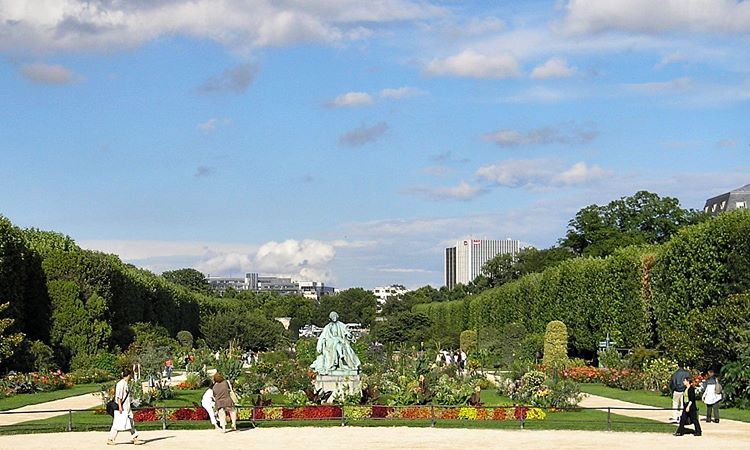
- Location: Rue Cuvier, 5th arrondissement
- Metro stations: Austerlitz (Lines 5, 10), Jussieu (Lines 7, 10), Place Monge (Line 7)
Jardin des Plantes is the city’s botanical garden and a beautiful green haven best known for its formal gardens. It’s hard to miss the four large greenhouses, home to exotic plants from the tropical, desert and arid regions. The Rose Garden features varieties of roses and the Alpine Garden to highland plants from around the world.
Hop-on Hop-off Bus Tours

Hop-on hop-off tours are one of the best ways to explore Paris. Get on and off at any stop along the route or enjoy the entire trip without leaving the bus. Sure, hop-on hop-off buses cost more than public transport to get around. But they offer good value, allowing tourists to see and visit more places than travelling on their own.
The tour buses follow designated routes, making stops near several main attractions. Get off at the stop you want, explore at your own pace, and then board another bus to the next destination. But you don’t have to get off the bus. You can sit down, relax and enjoy the entire trip without leaving the bus.
For families with kids as well as the elderly, the tours make it easy to get around and enjoy the sights. They are a great way to explore the city if you’re here for a short stay. And a great introduction to Paris if it’s your first visit. There’s an audio guide with the tour and available in several languages including French, English, German and Spanish.
Hop-on hop-off tours by Tootbus, Big Bus and Foxity are good options. Tootbus offers 1 to 3-day passes while Big Bus and Foxity have 1 to 2-day passes. Each has its own routes, stopping near many major attractions. Check out their websites for options, prices and promotions before deciding to book.
Boat Tours of Paris

A visit to Paris wouldn’t be complete without joining a cruise on the River Seine. You’ll pass by some of the city’s most famous sights such as the Eiffel Tower, Place de la Concorde, Notre Dame Cathedral and Hôtel de Ville. There are several options and whichever cruise you choose, they are a relaxing way to see the sights of the city.
The Batobus operates just like a hop-on hop-off tour bus except it’s a boat. To use the service, buy a pass valid for 1 day (adult €19 and kids €9) or 2 days (adult €21 and kids €11). There are 9 BatoBus piers along the river. And you can hop on and off on any pier, and as many times as you want within the validity period.
A round trip on the BatoBus last 2 hours or so, since they stop at 9 piers. If you prefer, there are non-stop cruises that make 1-hour round trips. Boarding and return for most of these cruises are at the pier near the foot of the Eiffel Tower. Day cruises as well as evening cruises are available and cost around €16 for adults and €8 for kids.
There are also evening dinner cruises if you want to live it up. Some even offer live entertainment. These evening cruises start from around €50 to €150. Dinners are 2 or 3-course meals depending on the cruise. And dining is inside the lounge with your own private table. Usually, there’s an open deck for panoramic views.
Best Places to Shop
Paris is one of the best cities in the world for shopping. After all, it’s a fashion capital and a gold mine of boutiques, flagship stores, department stores and shopping centres. Shopping here caters to all budgets from the top names in luxury to affordable labels. Even if you don’t plan to shop, you can always enjoy window shopping.
There’s a one-month sales in January-February and June-July. Dates change each year, so check the web. The two sales periods offer big savings and you can expect 30 to 70 percent off from participating stores. In addition, non-EU residents can claim a value added tax (VAT) refund. Mastercard and Visa are widely accepted.
Avenue des Champs-Élysées
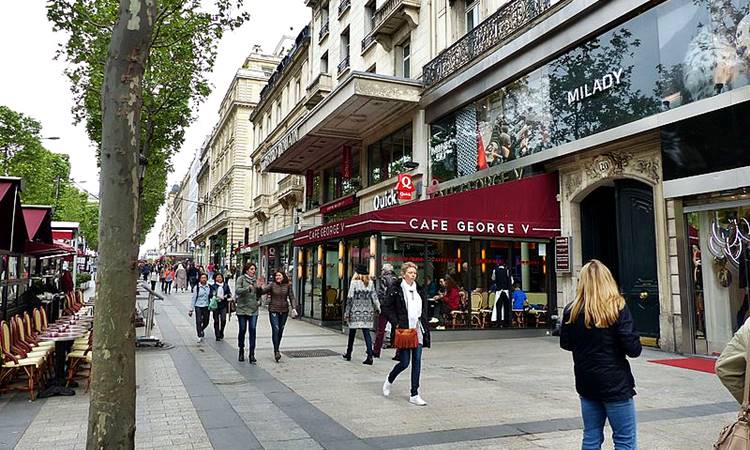
- Location: 8th arrondissement
- Metro stations: George V (Line 1), Franklin D. Roosevelt (Lines 1, 9)
Ritzy Champs-Élysées is brimming with upscale boutiques and flagship stores with the likes of Louis Vuitton, Boss, Lacoste, Cartier and Tiffany. There are also affordable labels like Zara, H&M, Celio and Tara Jarmon. The avenue is a touristy stretch and there are no shortages of shops and street kiosks selling overpriced souvenirs.
Rue St-Honoré
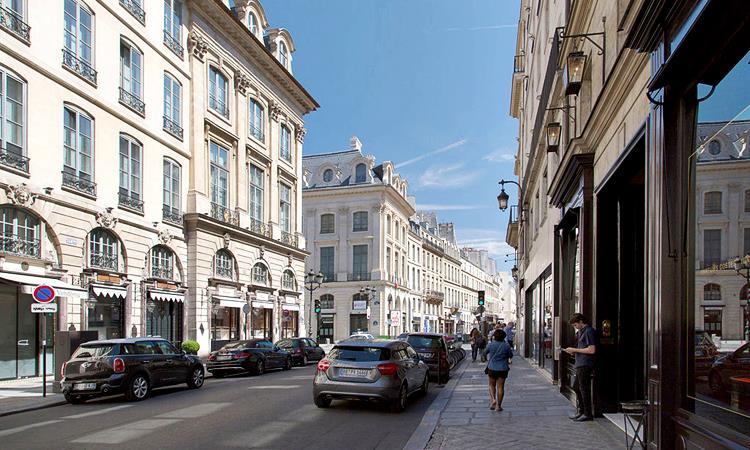
- Location: 1st arrondissement
- Metro stations: Concorde (Lines 1, 8, 12), Tuileries (Line 1), Palais Royal-Musée du Louvre (Lines 1, 7), Les Halles (Line 4)
Rue St-Honoré is another street of opulent boutiques and flagship stores occupied by the most fashionable names in luxury. Surrounding the famous square of Place Vendôme are some of the most exclusive boutiques for fine jewellery and watches. Among them are Gucci, Chanel, Chopard and Rolex but a visit is by appointment only.
Rue de Rivoli

- Location: 1st and 2nd arrondissements
- Metro stations: Tuileries (Line 1), Palais Royal-Musée du Louvre (Lines 1, 7), Louvre-Rivoli (Line 1), Châtelet (Lines 1, 4, 7, 11, 14), Hôtel de Ville (Lines 1, 11)
Rue de Rivoli is 6.4 km (4 miles) long and offers plenty of shopping opportunities. The stretch is a hodgepodge of independent boutiques, retail chains, shopping malls and department stores. It’s more affordable labels here with names like Zara, Bershka, Minelli and Mango. The street is also famous for vintage shops and retro fashion.
Rue du Commerce
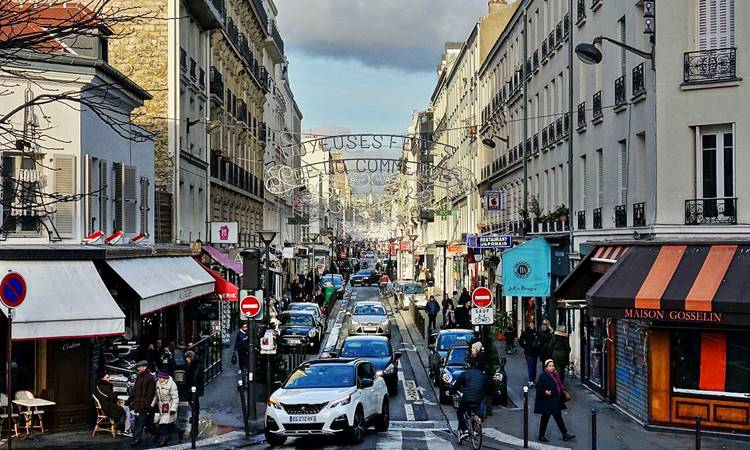
- Location: 15th arrondissement
- Metro stations: Commerce (Line 8), Avenue Émile Zola (Line 10), La Motte-Picquet Grenelle (Lines 6, 8, 10)
Rue du Commerce is a short humble stretch and a world apart from the prestige of Champs-Élysées. But a great place for budget-friendly prices. And there are more than 100 independent shops and retail chains on this street. There’s plenty to buy including casual wear, fashion, children’s clothes, shoes, watches and costume jewellery.
Boulevard Haussmann

- Location: 8th and 9th arrondissements
- Metro stations: St-Augustin (Line 9), Havre-Caumartin (Lines 3, 9), Chaussée d’Antin-La Fayette (Lines 7, 9), Richelieu-Drouot (Lines 8, 9)
The main shopping stretch on Boulevard Haussmann is between St-Augustin and Richelieu-Drouot Metro Stations. It’s a host of independent boutiques, major retailers and department stores. Don’t forget the small side streets namely Rue de l’Arcade, Rue Tronchet, Rue Vignon and Rue de Caumartin for hidden gems by French labels.
Galeries Lafayette

- Location: Boulevard Haussmann, 9th arrondissement
- Metro station: Chaussée d’Antin-La Fayette (Lines 7, 9)
Galeries Lafayette is the largest department store in France. Opened in 1912, this shopping icon is the flagship store. There are four huge floors of shopping inside the Art Nouveau interior. It’s upmarket and has a broad range from designer clothes to gourmet foods. Even if you don’t plan to shop, you just have to visit this place.
Printemps
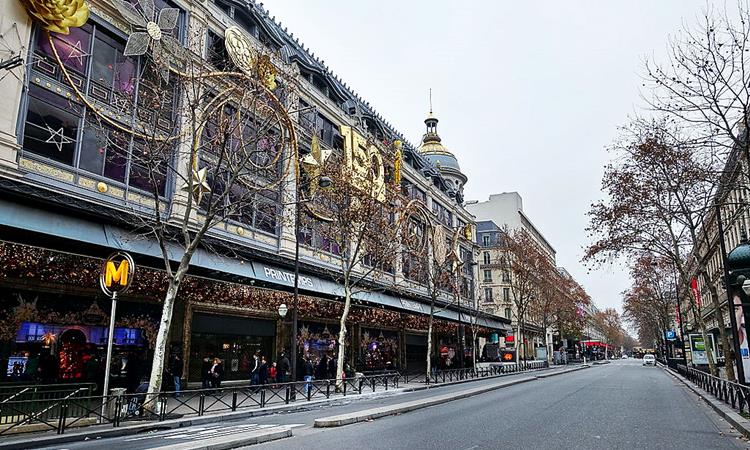
- Location: Boulevard Haussmann, 9th arrondissement
- Metro station: Havre-Caumartin (Lines 3, 9)
Printemps is another famous department store on Boulevard Haussmann and also the flagship store. Opened in 1865, it’s smaller than Galleries Lafayette but still huge and made up of three buildings. The department store is a showcase of luxury with spaces devoted to high-end clothing, fine jewellery, luxury watches, beauty and more.
Le Bon Marche

- Location: Rue de Sèvres, 7th arrondissement
- Metro station: Sevres-Babylone (Lines 10, 12)
Le Bon Marche was the world’s first department store when it opened in 1852. It’s a world of classy shopping that includes two huge buildings connected by a glass walkway. You’ll only find top selections from prestigious brands here. It’s a podium of luxury and you can even reserve a personal guide to assist you.
Beaugrenelle Paris
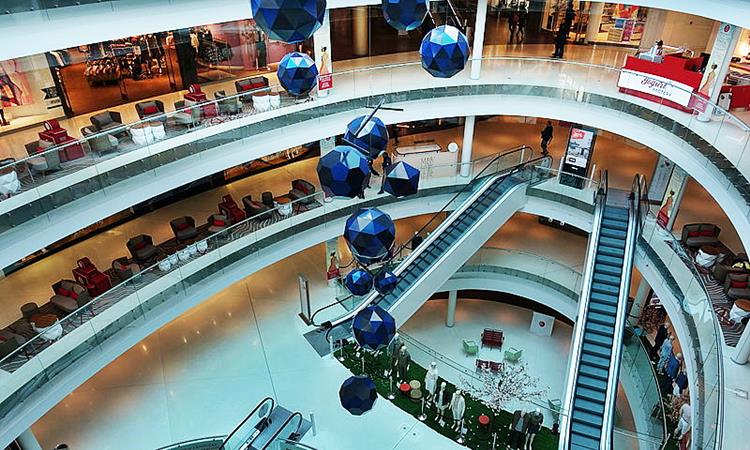
- Location: Rue Linois, 15th arrondissement
- Metro station: Charles Michels (Line 10)
Beaugrenelle Paris is chic, modern and one of the largest shopping centres in the city. This multi-level shopping heaven is home to 120 shops and restaurants. There are retailers devoted to fashion, leather goods, shoes, jewellery, accessories and beauty. Among the leading brands are H&M, Zara, Lacoste, Uniqlo, Celio and Nike.
Westfield Forum des Halles

- Location: Porte Berger, 1st arrondissement
- Metro station: Les Halles (Line 1), Châtelet (Lines 1, 4, 7, 11, 14)
Westfield Forum des Halles (Forum des Halles) is a large shopping centre near the Louvre Museum. It’s mostly underground and sprawls four floors. You’ll find more than 110 retailers here including big names in retail. For the budget-minded, Monoprix offers from everyday clothes to food at very low prices.
Guide to Eating Out
You’ll be delighted with over 40,000 eateries in Paris ranging from humble takeaways to fine dining. Expect over-priced meals in touristy areas like Avenue des Champs-Élysées. Head to where the locals go, especially the side streets, for cheaper eats and better food. Prices are the same at the same fast food chain wherever you go.
You don’t have to tip and it’s not rude if you don’t. In France, a sit-down restaurant will add a 15 per cent service charge to the bill. You may tip if you want and there’s no standard amount but typically 5-10 per cent. Some self-service restaurants and takeaways may put a tip jar at the counter. It’s entirely up to you and many don’t.
Budget-Friendly Eats in Paris

If you prefer a quick bite or don’t want to nip away your budget, you can always depend on fast food. Yes, there’s fast food in the city of Michelin star restaurants. Just because fast foods are lighter on the wallet, it isn’t junk food. Fast foods are popular with Parisians and a culinary experience of its own.
You’ll find tiny shops across the city selling low-budget meals for takeaway – some may have a small seating area. Middle Eastern kebab shops are popular and almost on every street corner. Beyond kebabs are shops offering French-style burgers, baguette sandwiches, shawarma, souvlakis, falafel, tacos and crêpes to name a few.
In 2011, Le Camion Qui Fume was the first food truck to hit Paris and served some of the best burgers in town. There are now a lot more mobile restaurants on the streets. And more than just burgers including pizzas, bagels, fish and chips, braised chicken, empanadas, dim sum, crepes and even gourmet ice creams.
American fast foods include McDonald’s, Burger King, KFC, Subway and Five Guys. McDonald’s has a French twist in France. The chains have French-style interiors and besides the classic fare, there are French offerings like Alpine Burgers, McBaguette sandwiches, thick-cut potatoes, macrons, croissants and canelés.
Try France’s own fast food chains. They offer inexpensive quick meals but not a copy of the all too familiar American fast food restaurants. The local chains are uniquely French.
- Cojean champions healthy foods with a range of hot dishes, sandwiches, soups and salads that also include vegetarian and vegan options.
- Mister Garden is a salad bar where you can choose the restaurant’s signature salad dish or create your own with a wide range of sauces.
- Nabab Kebab is popular for the varieties of naan (flatbread), sandwich and plate dishes with choices of kebab meat and chicken tikka.
- O’Tacos offers a French version of hearty tacos – actually a burrito – where you can choose the size, meat, topping and sauce.
- Bagelstein serves bagel sandwiches as well as salads, side dishes and tempting desserts like cheesecakes, crumbles and fruit salads.
Traditional Restaurants
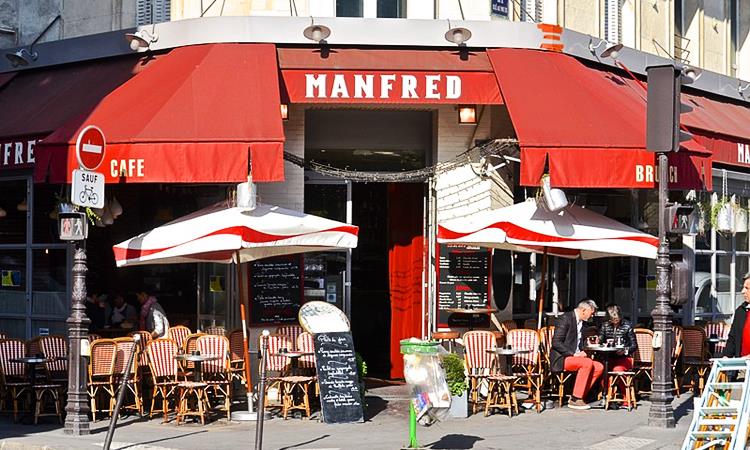
Cafés are a French staple and it’s hard to imagine Paris without it. It’s more than just about the food. They are also favourite places where Parisians hang out. Primarily for drinks and snacks but many also serve breakfast (€8-10) and light lunch (€10-15). Cafés open around 7 AM and remain so until evening.
Bistros are small informal restaurants offering a limited range of simple meals at reasonable prices. Brasseries are larger restaurants that offer a wider range of meals. Most are moderately priced but there are upmarket brasseries that charge a lot more. Whether a bistro or brasserie, you can expect classic French dishes.
Go for the prix-fixe set lunch instead of à la carte. Set lunches are 20-30 per cent less than separate orders. There are usually a couple of options in the set menu which typically includes a bowl of soup or salad, the main course and dessert. Set menus are around €15 at a budget, €25 at a mid-range and €40 at an upmarket restaurant.
Bistros and brasseries open for lunch from around 12 PM to 2 PM and dinner from 7 PM to 10 PM. Some larger brasseries remain open throughout the day until dinner. Contrary to popular belief, not all close on Sundays. French law requires the menu and the prices to be shown outside the door. So check before you enter.
Finding Halal Foods
It’s not hard to find halal eateries in Paris. There are actually quite a lot. The city has a large Muslim community largely from North Africa, West Africa and the Middle East. This accounts for the number of takeaways and restaurants from the regions serving halal foods. You can easily identify an eatery serving halal foods with the “halal” sign.
Kebabs are popular with Parisians and many are small modest outlets serving halal foods. It’s a hearty range and a typical chicken kebab wrap with fries costs around €8. Foods served by the popular fast food chain Nabab Kebab are halal. O’Tacos is another popular fast food chain using only halal-certified meat.
Finding Kosher Foods
Paris is also home to a large Jewish community with a history with the city that goes back centuries. When it comes to eating, you’ll find kosher takeaways, restaurants, bakeries and pastry shops. Kosher restaurants here serve a wide variety of cuisines including French, Italian, Israeli, Middle Eastern, American and even Chinese.
There are over 100 kosher eateries in the city. A good place to go is Rue des Rosiers and the nearby streets in Le Marais. The area is a famous Jewish neighbourhood where you’ll find a host of kosher takeaways, restaurants and bakeries. Check out Kosher in France for a list of kosher establishments in Paris.
Finding Vegetarian Foods
France is a country of meat eaters. A French person might assume you eat chicken or at least fish if you say you don’t eat meat. Many cafés, bistros and brasseries would have suitable options for vegetarians but less certain for vegans. Luckily there are pockets of vegetarian and vegan restaurants. Just do a web search.
You can often find sandwiches suitable for vegetarians and vegans. Falafel is a popular vegan food. Fast food chains Cojean and Mister Garden include vegetarian and vegan dishes. Quick offers its classic veggie burgers. Many North African, Middle Eastern and Asian restaurants also have suitable dishes in their cuisines.
How to Get to Paris
Being a popular travel destination, Paris is certainly well-connected by air, rail and road with routes radiating in all directions. As a matter of fact, France has one of the world’s best transport systems. And Paris is easily accessible from many cities in France and major transport hubs across the globe.
Three airports serve Paris including Charles de Gaulle, Orly and the smaller Beauvais Airport. The city has six main railway stations and Gare de Nord is the station for trains arriving from London. If travelling by bus, there are a couple of stations but Gare Routière Internationale and Gare de Paris Bercy are the most likely for visitors.
Flying to Paris

Charles de Gaulle, Orly and Beauvais Airports together are one of the busiest airport networks in the world. You can get to Paris from many major cities around the world. It’s also well connected with other French cities including Toulouse, Toulon, Lyon, Marseilles, Nice, Montpellier, Rennes, Ajaccio and Bastia.
Charles de Gaulle International Airport
Charles de Gaulle Airport is 23 km (14 miles) northeast of Paris. It’s the largest and busiest France and the hub for the national flag carrier Air France. Besides flights within Europe, you’re most likely to land here if arriving from outside the continent. There’s good transport to Paris including trains, shuttle buses (Roissybus) and taxis.
Orly International Airport
Orly Airport is 13 km (8 miles) south of Paris. It’s the second busiest airport in France and the secondary hub for Air France. Flights are mostly within Europe and a few cities in the United States, Morocco, Algeria, Tunisia and the Caribbean. The airport is well served by trains, shuttle buses (Orlybus) and taxi services to Paris.
Paris Beauvais Tillé Airport
Paris Beauvais Tillé Airport is 85 km (53 miles) northwest of Paris. It’s the smallest of the Paris airports and used mainly by charter and budget airlines. Ryanair and Wizz Air are major carriers with flights mainly between holiday destinations in Europe. Shuttle buses depart regularly from the airport to Porte Maillot Metro Station in Paris.
To Paris by Train
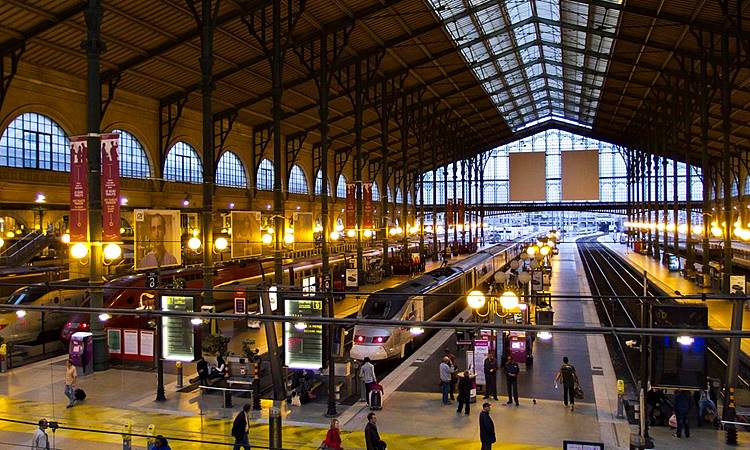
The French capital is the hub for train travel in France and the trans-European routes. It’s mostly driven by high-speed trains and getting to Paris is much faster than the buses. There’s no central station but six railway terminals in Paris. Each serves different routes, passing through various regions of France and countries in Europe.
Eurostar from London to Paris
High-speed Eurostar passenger trains (passing under the English Channel) link Paris with London. St Pancras International is the Eurostar terminal in London while Gare du Nord is the station in Paris. Trains travel up to 300 kph (186 mph) and a trip takes around 2 hours. You’ll enjoy significant savings if you book tickets well in advance.
Railway Terminals in Paris
With 6 railway terminals, know in advance which station your train is arriving or departing. Transport from the terminals includes the Metro trains and RER regional trains serving Paris and the suburbs. You’ll also find taxis waiting outside.
- Gare du Nord (North Station) – This is the busiest railway station in Paris. Trains here pass through northern France, Belgium, Netherlands and Germany.
- Gare Saint-Lazare (Saint-Lazare Station) – The second busiest station. Trains pass through Normandy in the northwestern region of France.
- Gare de l’Est (East Station) – It’s a 10 minutes walk from Gare du Nord. Trains pass eastern France, Luxembourg, Germany and Switzerland.
- Gare de Lyon (Lyon Station) – Trains pass southeastern France, Italy, Switzerland and Spain. A bus service links the station with Charles de Gaulle Airport.
- Gare d’Austerlitz (Austerlitz Station) – It’s across the River Seine from Gare de Lyon. Trains pass central France and then to Bordeaux in southwestern France.
- Gare Montparnasse (Montparnasse Station) – Trains pass through western and southwestern France. The station is not served by RER trains.
To Paris by Bus

Buses are the cheapest way to get around Europe. And Paris is well connected to many major cities in France and across Europe. Though a great way to travel if you plan to save money, it’s not the quickest. Over a distance of 780 km (485 miles), it takes 4 hours from Marseille to Paris on the high-speed train but 10 hours by bus.
Gare Routière Internationale
Gare Routière Internationale (International Bus Station) is the main station for long-distance buses in Paris. It’s next door to Gallieni Metro Station serving Line 3, which passes the city’s central area. Taxis are also available if you need one. You can purchase tickets at the station if you haven’t booked online for your onward journey.
Eurolines is the main carrier here, connecting more than 20 cities in France including Toulouse, Marseille, Nice and Lyon. Eurolines also links with cities in over 20 European countries including Amsterdam, Brussels, Düsseldorf, Munich, Berlin, Madrid and Barcelona. In London, board the Eurolines bus to Paris at Victoria Coach Station.
Gare de Paris Bercy
Gare de Paris Bercy is a railway station but is also used as a bus terminal by BlaBlaBus, Flixbus and Alsa. They may stop at other places in the city but Gare de Paris Bercy is the main station. BlaBlaBus and Flixbus connect with many cities in France and Europe. Alsa connects Paris with the Spanish cities of Madrid and Barcelona.
How to Get Around
You can easily walk around Paris but off and on you’d need transport. Operated by RATP, the city has an extensive and efficient public transport system that includes the Metro and RER trains, buses and funicular railway at Montmartre. Trams are available but tourists are unlikely to use them since they cover the suburbs.
You can rent a car but avoid driving unless you plan to spend most of your time outside the city. There are heavy traffic, aggressive drivers, confusing road signs and many narrow one-way streets. With one of the world’s best public transport systems, you don’t really need to drive to get around. Besides, there are taxis if you need one.
Tickets for Public Transport
All the city’s public transport uses the same t+ tickets. You can buy the tickets either from the manned counters or machines at the Metro and RER stations. A single adult ticket costs €1.90 but €2.00 if bought on the bus. Kids under 4 years travel free and bigger kids 10 years and below pay half price.
The €1.90 ticket (€2.00 if bought on the bus) is good throughout the length of the journey. Exceptions are the RER trains, the €1.90 fare is only good within the city and it’s a different fare for travelling beyond. Except for tickets bought on the buses, you can make the following transfers between the first and last validation.
- Between Metro trains – within 2 hrs
- Between RER trains (in Paris only) – within 2 hrs
- Between Metro and RER (in Paris only) – within 2 hrs
- Between buses – within 90 mins
- Between trams – within 90 mins
- Between bus and tram – within 90 mins
Pay with a t+ digital ticket using the Navigo Easy pass. The reloadable card costs €2 which you can buy at the Metro or RER stations. It’s free if you download the Bonjour RATP phone app. A t+ adult ticket cost €1.90 but €14.90 for a set of 10 – half price for kids aged 4-10 years. You can transfer between transport within 90 minutes.
Passes for Public Transport
Navigo & Mobilis 1-Day Passes
If travelling a lot, the Navigo and Mobilis 1-day passes offer unlimited travel. The two are the same except the Navigo pass is via the Bonjour RATP app while Mobilis is a magnetic card bought at the Metro or RER stations. Cost depends on the transport zones covered, which ripple out in circles starting from Zone 1 in the centre.
- Zones 1 and 2 cover areas within the city.
- Zones 3 covers the outlying areas nearest the city.
- Zone 4 covers the greater Paris region outside zone 3.
- Zone 5 covers greater Paris outside zone 4.
| Zones | Cost (€) |
|---|---|
| 1-2, 2-3, 3-4, 4-5 | 7.50 |
| 1-3, 2-4, 3-5 | 10.00 |
| 1-4, 2-5 | 12.40 |
| 1-5 | 17.80 |
Zones 1 and 2 are where you’ll find most of the tourist attractions and accommodations. Popular tourist spots in Zone 3 include the La Défense business district and Saint Ouen Flea Market. The Palace of Versailles and Orly Airport are in Zone 4. Disneyland Paris, Charles de Gaulle Airport and Château de Fontainebleau are in Zone 5.
Paris Viste Passes
Another is the Paris Viste offering visitors 1, 2, 3 and 5-day passes for unlimited travel. Unlike Navigo and Mobilis, the Paris Viste only for travelling in Zones 1-3 and 1-5. Is the Paris Viste cheaper than Navigo or Mobilis? It depends on the number of days you plan to travel and zones you want to cover.
| Days | Zones 1-3 (€) | Zones 1-5 (€) |
|---|---|---|
| 1 | 12.00 | 26.25 |
| 2 | 19.50 | 38.35 |
| 3 | 26.65 | 53.75 |
| 5 | 38.35 | 65.80 |
Visit the RATP website for more info about tickets and passes.
By Metro Train

The Metro trains operate 7 days a week from 5:30 AM to midnight. A total of 16 interconnected lines cover Paris. Each line has a number, and colour code and is often called by the name of the end station. With 300 stations, you’re often not far from a Metro station. Trains are regular and you can expect one to arrive every 8-10 minutes.
The Metro network is easy to use and a reliable way to get around. Sure enough, it’s the most popular public transport for tourists. A Metro map makes a handy guide for getting around on the trains. You can usually get one from the hotels, tourist information offices or download a digital map from the RATP website.
By RER Train

RER (Réseau Express Régional) is a regional train serving Paris and the suburbs. There are 5 lines (A, B, C, D and E) operating from around 4:30 AM until midnight. RER trains are not as frequent as the Metro but are faster since they make fewer stops. So use the RER if you can get to your destination faster than the Metro.
A trip on the RER using a t+ ticket is valid only within Paris which is in Zones 1 and 2. Beyond the two zones into the outlying areas (Zones 3, 4 and 5), then you’d have to purchase a RER ticket and pay by the distance. Or use a pass for unlimited travel like the Navigo, Mobilis or Paris Viste that can cover trips beyond Zones 1-2.
By Public Bus
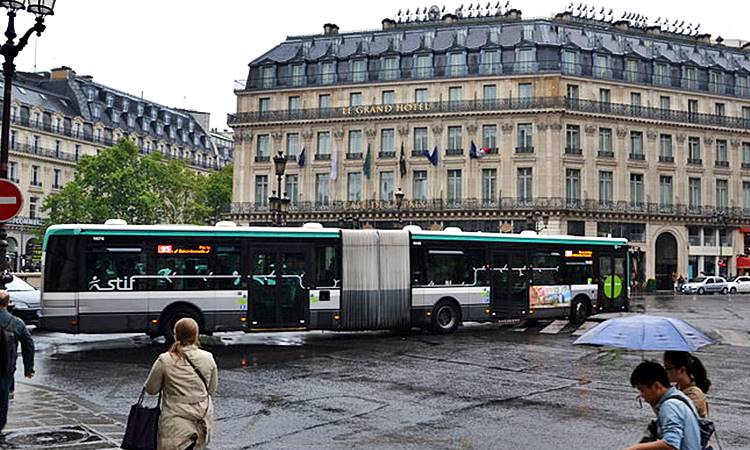
Getting around on the RATP public buses may not appeal to many tourists. Figuring out how to get around during a brief stay is too much of a hassle for many. But buses can get you to more places than the Metro. They are also a cheap way for admiring views of Paris, which the Metro can’t offer since it’s mostly underground.
There are more than 60 day routes running from around 6:00 AM until 12:45 AM. There are also night buses called Noctilien covering 40 routes from 12:30 AM to 5:30 AM. The following are routes that pass through some of the city’s popular tourist attractions. You can download the Paris bus map from the RATP website.
- Line 22 – Eiffel Tower, Grands Boulevards, Palais Garnier, Place Charles de Gaulle, Arc de Triomphe and Boulevard Haussmann.
- Line 38 – Latin Quarter, Porte St-Martin, Hotel de Ville, Notre Dame, Jardin du Luxembourg and Sorbonne.
- Line 42 – Eiffel Tower, Champs-Elysees, Grand Palais, Petit Palais, Place de la Concorde, Tuileries Gardens, Galeries Lafayette and Printemps.
- Line 72 – Place de la Concorde, Tuileries Gardens, Musée du Louvre, River Seine, Hotel de Ville and Eiffel Tower.
- Line 80 – Grands Boulevards, Montmartre Cemetery, Place de Clichy, Avenue Montaigne and Eiffel Tower.
- Line 89 – Latin Quarter, Jardin du Luxembourg, Panthéon, Jardin des Plantes and La Mosquée at Buffon.
By Taxi
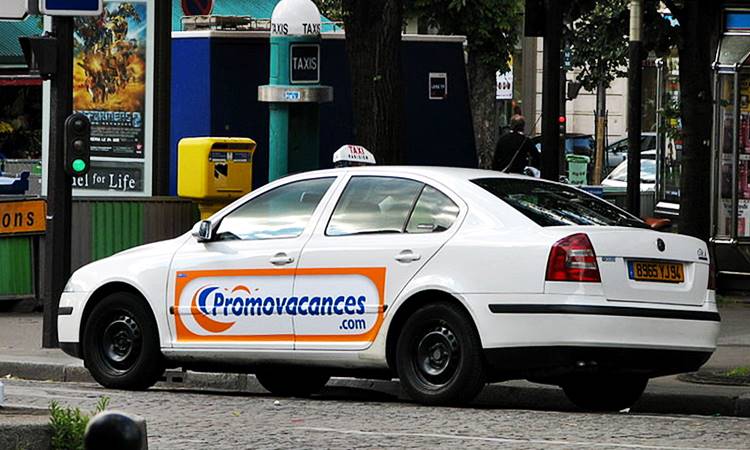
It’s fairly easy to catch a taxi in the central area. Flag for one on the streets or go to the nearest taxi stand. You’ll often find the stands located near major stations, big hotels, busy squares and popular tourist spots. If you don’t speak French, write the name and address of the destination to show the driver since many don’t speak English.
Taxis in Paris use normal cars with the “Taxi Parisien” sign on the roof. All use the meter with rides starting at €4.10 but the minimum fare is €7.10. To give you an idea, it costs around €15 for a 10 minutes trip, €20 for 20 minutes and €25 for 30 minutes. Some drivers accept payment by card and some don’t, so have sufficient cash.
Yes, there’s Uber in Paris. Uber will show the fare on your phone app before booking. There’s no language barrier using Uber because the driver can see your destination on the app before picking you up. But is Uber cheaper than taxis? Sometimes and the savings is often not a big amount. And you can’t flag an Uber on the street.
Where to Stay in Paris

The 1st to 8th arrondissements (districts) are in the central area where you’ll find most of the city’s attractions. Outside the central area are the 9th to 20th arrondissements, mostly residential but there are interesting locations. You’ll spend more time travelling staying outside the central area but rooms are certainly much cheaper.
There are plenty of great locations for visitors to stay in Paris, whether within or outside the central area. Where you stay depends on your preference and budget. That said, you’d want to stay near a Metro station. The map below will help you find your preferred location. Click the links on the markers for a brief description of the locations.
1st Arrondissement
- Mostly high-priced 3 to 5-star hotels
- Check out hotels in the 1st arr.
The 1st arrondissement is in the heart of Paris. You’ll find many of the city’s famous attractions including Musée du Louvre, Musee de l’Orangerie, Tuileries Garden and Palais-Royal. It’s also a paradise for shoppers and home to some of the top shopping streets in Paris including Rue de Rivoli and Rue St-Honoré.
Le Marais (4th Arr.)
- Mostly 3 to 5-star hotels
- Check out hotels in Le Marais
Le Marais is a historic and cultural quarter of Paris. It’s home to grand mansions, secluded courtyards, elegant streets and a labyrinth of alleyways. Famous attractions include Centre Pompidou, Picasso Museum and Hôtel de Ville. Besides history and culture, Le Marais is also lively with a thriving café scene and bustling nightlife.
Latin Quarter (5th and 6th Arr.)
- Mostly 3 and 4-star hotels
- Check out hotels in the Latin Quarter
The Latin Quarter is one of the oldest districts in Paris. There’s an old-world charm with its antique buildings, a maze of narrow streets and cobblestoned lanes. Beyond history, it’s also a lively place with entertaining nightlife. For fans of indie and classic films, the quarter is home to more than 15 arthouse cinemas.
St-Germain-des-Prés (6th Arr.)
- Mostly 3 and 4-star hotels
- Check out hotels in St-Germain-des-Prés
St-Germain-des-Prés is the classic Paris on the postcard that tourists often think about. The neighbourhood has a rich heritage but also has an energetic vibe and flourishes with sidewalk cafés, bistros and brasseries. On top of all that, there are theatres, cinemas, art galleries and plenty of shopping from fashion to antiques.
8th Arrondissement
- Mostly 3 to 5-star hotels
- Check out hotels in the 8th arr.
The 8th arrondissement is an elegant area of 19th-century Haussmann architecture. It’s also home to many historic attractions including Arc de Triomphe, Place de la Concorde and Petit Palais. And there’s the famous avenue of Champs-Élysées, a chic and bustling street filled with stylish boutiques, posh cafés and restaurants.
9th Arrondissement
- Mostly cheaper 3 and 4-star hotels
- Check out hotels in the 9th arr.
The 9th arrondissement is a residential and business district occupied by cafés, bistros and brasseries. There’s plenty to shop on Boulevard Haussmann and where you’ll find the famous Galeries Lafayette and Printemps department stores. Though outside the central area, it’s within easy reach from the 1st and 2nd arrondissements.
11th Arrondissement
- A mix of budget, 3-star and cheaper 4-star hotels
- Check out hotels in the 11th arr.
The 11th arrondissement is mostly residential. It’s cosmopolitan and a cool part of Paris. A great place if you want to stay where the locals live. You’ll find charming squares, parks, galleries, boutiques and lively markets. Rue de Charonne is a popular street for dining and Rue Oberkampf for its vibrant nightlife.
12th Arrondissement
- A mix of budget, 3-star and cheaper 4–star hotels
- Check out hotels in the 12th arr.
The 12th arrondissement is primarily residential and off the radar with most tourists. That said, this Parisian neighbourhood has its share of history and culture. There are also street markets, cafés, restaurants and shops. Not to mention Bois de Vincennes (the largest park in Paris) and Bercy Village (a famous shopping centre).
Montparnasse (14th Arr.)
- A mix of budget, 3-star and cheaper 4-star hotels
- Check out hotels in Montparnasse
Though Montparnasse is outside the central area, it’s not too far from the key attraction and is easy to get around. Besides, the neighbourhood has its own attractions including Les Catacombes de Paris and Tour Montparnasse. Though a quiet part of Paris, the area near Tour Montparnasse is a popular foodie hangout with plenty of dining options.
Batignolles (17th Arr.)
- A mix of budget, 3-star and cheaper 4-star hotels
- Check out hotels in Batignolles
Batignolles is in a quiet residential corner of Paris and off the tourist route. It’s laidback and humble but a charming neighbourhood. The centre of life is around Église St-Marie, a 19th-century church. Not a big area to explore but pleasant with shops, cafés and bistros to enjoy your time. Nightlife around the church is modest and relaxed.
Montmartre (18th Arr.)
- A mix of budget, 3-star and cheaper 4-star hotels
- Check out hotels in Montmartre
Montmartre is not the Paris that most visitors imagine. As a matter of fact, it’s a village in a city. Situated on a hill, it’s a network of cobbled streets, alleyways, hidden steps and rustic buildings. On top of the hill is the famous Sacré-Coeur Basilica. The main street is Rue des Abbesses, a quaint stretch packed with tiny shops, cafés and bistros.
Best Day Trips From Paris
If you’re staying a couple of days in Paris and have time to spare, consider a day trip outside the city. Sure, the French capital has tons of engaging attractions. But France has more to offer with several fantastic places to visit for day trips from the city. Besides, you get to see a cross-section of France during the journey.
Take the fast trains from Paris and go on your own or book a bus tour. Going on your own is certainly cheaper than a bus tour and you can wander at your own pace. But bus tours save you the chore of planning a trip, buying tickets, changing transport and finding your way around. Which option is the best depends on your preference.
Disneyland Paris

- Location: Chessy, Marne-la-Vallée
- Train station: Marne-la-Vallée Chessy
- Journey time: 40 mins
- See tickets and transfers to Disneyland Paris
Disneyland Paris (originally Euro Disneyland) includes Disneyland Park, Walt Disney Studios Park and Disneyland Village. It’s a great trip for families offering lots of attractions including fun rides and animatronics. You may want to avoid coming here in July and August. These are the busiest and most crowded months.
La Vallée Village Shopping Outlet

- Location: Serris, Marne-la-Vallée
- Train station: Gare De Val D’Europe
- Journey time: 40 mins
- See transport and day trips to La Vallée Village
La Vallée Village is a unique open-air shopping centre laid out as a village. It’s home to nearly 110 boutiques occupied by top names in fashion including international and French labels. You’ll find famous brands like Gucci, Prada, Bottega and Calvin Klein to name a few. The big draw is the discounts, which are up to 60 per cent less!
Château de Versailles
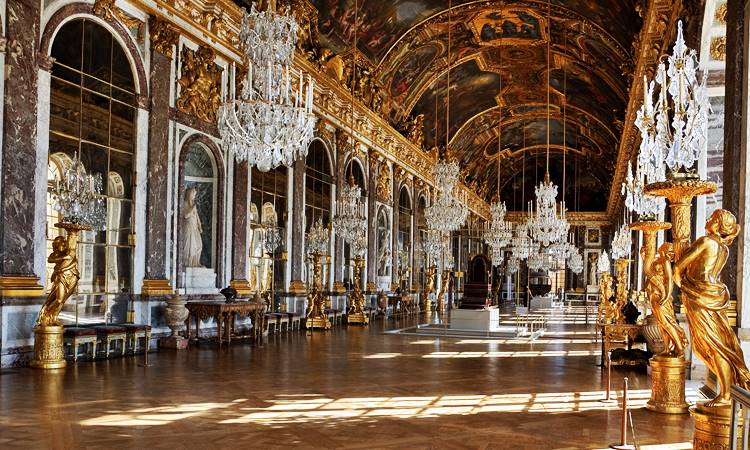
- Location: Place d’Armes, Versailles
- Train station: Versailles Château Rive Gauche
- Journey time: 60 mins
- See tickets and day trips to Château de Versailles
Château de Versailles (Palace of Versailles) is a colossal place built in the 17th century and once home of the French kings and the seat of royal power. The palace features lavishly decorated hallways, galleries, rooms, apartments and chambers. And the gardens are stunning with beautiful flowerbeds, rock gardens, ponds and fountains
Château de Fontainebleau

- Location: Fontainebleau
- Train station: Fontainebleau-Avon
- Journey time: 60 mins
- See tickets and day trips to Fontainebleau
Fontainebleau is a charming town surrounded by the scenic Fontainebleau Forest. The highlight of the visit is Château de Fontainebleau and its gorgeous gardens. This imposing palace with 1,500 rooms goes back to the 12th century and was once a royal residence. It’s another luxurious palace with majestic halls and lavishly ornate rooms.
Picturesque Village of Giverny

- Location: Giverny
- Train station: Vernon-Giverny
- Journey time: 60 mins
- See day trips to Giverny
Giverny is an adorable French village on the bank of the River Seine. The main attraction is the house where Monet – the famous impressionist artist – once lived and his charming water garden. The village itself is a lovely sight occupied by adorable country homes. Not to mention a scenic countryside offering lovely nature walks.
Loire Valley Chateaux
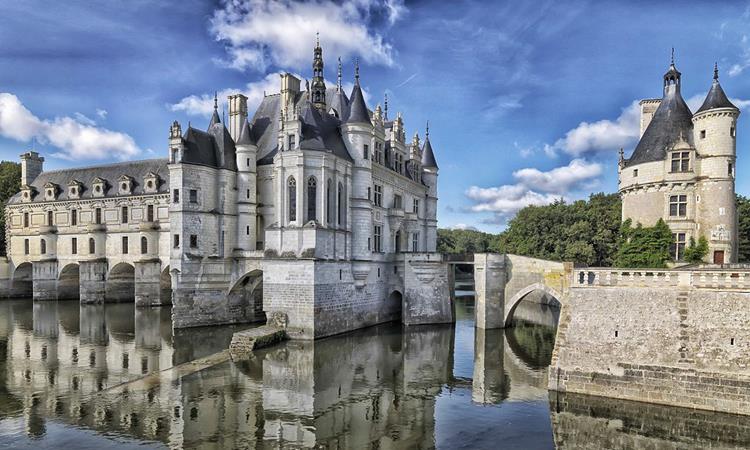
- Location: Loire Valley
- Train station: Tours Saint Pierre des Corps and Angers Saint-Laud
- Journey time: 1 hr 30 mins to 2 hrs (depending on the station)
- See tickets, passes and day trips to Loire Valley
The 280 km (170 miles) long Loire Valley has over 300 castles. These stunning castles go back centuries and the valley is a UNESCO World Heritage Site. Travelling on your own, the nearest station in Tours is Château de Tours and the station in Angers is Château d’Angers. Booking a bus tour would be a better option to cover more ground.
Normandy D-Day Landings

- Location: Bayeaux
- Train station: Gare de Bayeux
- Journey time: 2 hrs 30 mins
- See day trips to the Normandy Landings
Explore the history of D-Day on the beaches of Normandy during the Second World War. Visit the beaches where it happened as well as fortifications, bunkers, memorials, war cemeteries and museums. It’s a large area to cover unless you have a car. So book a mini-bus excursion when in Bayeaux or a bus tour departing from Paris.
The Abbey of Mont Saint-Michel

- Location: Mont Saint-Michel
- Train station: Gare de Rennes (then take a shuttle bus to Mont Saint-Michel)
- Journey time: 4 hrs
- See tickets and day trips to Mont St-Michel
The Abbey of Mont St-Michel sits on a small rocky island jutting out from the coast of Normandy. During medieval times, the abbey was a major religious site for pilgrimage. Today, this historic wonder is a UNESCO World Heritage Site. Walk along the ramparts and explore the narrow street occupied by medieval buildings.

